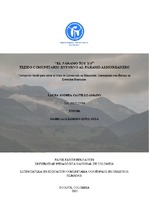“El páramo soy yo” tejido comunitario entorno al páramo Almorzadero.
Citación
Fecha
2023Autor
Castillo Amado, Laura Andrea
Director / Asesor / Tutor
Sepulveda, Mario Alejandro
Palabras claves
Páramo
Paramuno
Campesino
Sujeto de derechos
Delimitación
Participación
Educación EcoComunitaria
Metadatos
Mostrar el registro completo del ítemResumen
La presente investigación recoge las reflexiones y aportes teóricos que surgieron a partir de la practica pedagógica investigativa realizada con la población campesina paramuna del sector Bajo Chamaca, de la verada Carabobo en el municipio de Concepción, en el páramo Almorzadero en el departamento de Santander, Colombia. Esta consistió, principalmente, en tejer de manera conjunta con los habitantes del territorio espacios de dialogo y aprendizaje; al empezar a caminar colectivamente surgió desde la Investigación Creación, la composición de una pieza audiovisual, la cual permite dar cuenta de la realidad material, la cotidianidad y las relaciones que se construyen entre los paramunos en y con el territorio; con ello también se evidencian algunas condiciones de vida y de la misma manera ciertas problemáticas y perspectivas alrededor del proceso de delimitación del páramo Almorzadero. Este ejercicio permitió dar cuenta de la desinformación y desconocimiento por parte de los paramunos frente al marco jurídico que la delimitación trae consigo y en esa medida como podrían incidir para hacerse participes de la toma de decisiones que concierne a sus formas de vida y aquellas que les permita ser agentes de su territorio y organizar el mismo alrededor del agua contemplando sus derechos adquiridos en coexistencia con la biosfera. Es así como surge la categoría de investigación de Educación EcoComunitaria (EdECO), la cual permite hacer una lectura crítica consciente de la correlación y coexistencia de las personas con el ecosistema, en la que se reconozcan, a su vez, como actores fundamentales y activos, capaces de ejercer sus derechos e identificar las problemáticas y las dinámicas estructurales que los atraviesan para hacer frente a las mismas y construir de manera conjunta otras formas posibles y más dignas de habitar el mundo. Es así como partiendo de esta categoría se da la necesidad de materializar espacios de dialogo a partir de la EdECO en conjunción con la IAP. Para esto se desarrollaron 3 componentes, los cuales permitieron hacer un tránsito desde el espacio físico llamado páramo, pasando por lo que implica habitarlo, la importancia de conservarlo y la reivindicación de sus derechos contemplando acciones emancipadoras concretas que apunten a una vida digna en armonía con la naturaleza.
Abstract
The present research gathers reflections and theoretical contributions that emerged from the investigative pedagogical practice carried out with the paramunian peasant population of the Lower Chamaca sector, in the Carabobo hamlet of the municipality of Concepción, located in the Almorzadero páramo of the department of Santander, Colombia. This consisted mainly of jointly weaving dialogue and learning spaces with the inhabitants of the territory; as we began to collectively walk, the composition of an audiovisual piece emerged from Research Creation, which allows us to account for the material reality, the everyday life, and the relationships that are built among the paramunos in and with the territory; this also highlights some living conditions of these individuals, as well as certain problems and perspectives around the process of delimitation of the Almorzadero páramo. This exercise made it possible to realize the lack of information and knowledge on the part of the paramunos regarding the legal framework that delimitation brings with it and, to the extent, how they could influence to become participants in decision-making concerning their ways of life and those that allow them to be agents of their territory and organize it around water, considering their acquired rights in coexistence with the biosphere. Thus arises the category of EcoCommunity Education (EdECO) research, which allows for a conscious critical reading of the correlation and coexistence of people with the ecosystem, in which they are recognized, in turn, as fundamental and active actors, capable of exercising their rights and identifying the problems and structural dynamics that affect them, in order to confront them and jointly build other possible and more dignified ways of inhabiting the world. Based on this category, the need to materialize dialogue spaces from EdECO in conjunction with the IAP arises. For this, 3 components were developed, which allowed for a transition from the physical space called páramo, through what it implies to inhabit it, the importance of conserving it, and the vindication of its rights, as paramunos, contemplating concrete emancipatory actions aimed at a dignified life in harmony with nature.
Editorial
Universidad Pedagógica Nacional
Programa académico
Licenciatura en Educación Comunitaria con énfasis en DDHH

